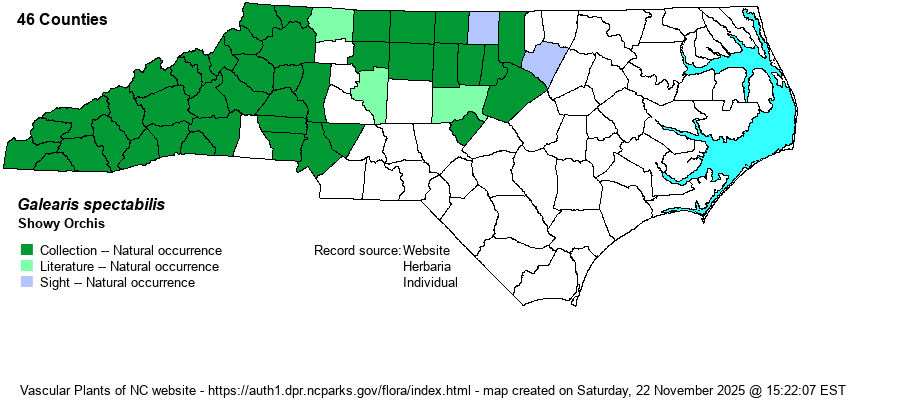| Author | (L.) Rafinesque | |
| Distribution | Found throughout the Mountains, and across nearly all of the Piedmont, though perhaps absent from the southeastern Piedmont. Does not occur in the Coastal Plain or Sandhills proper.
This rather Northern species occurs across southern Canada south to central NC, northern GA, and central AR. | |
| Abundance | Fairly common to frequent in the Mountains and western Piedmont; uncommon in the northern Piedmont, south to Forsyth and Wake counties, but absent to rare in the southeastern quarter of the Piedmont; very rare to absent in the far northeastern Piedmont, with apparently no records yet east of Granville and Franklin counties. | |
| Habitat | This species occurs in similar habitats as the Yellow Lady's-slipper (Cypripedium parviflorum), being a denizen of rich hardwood forests, mainly on lower slopes, as well as in forests in bottomlands and near wooded streams. It can occur in circumneutral soil over mafic rocks, especially more so in the eastern Piedmont. |
| Phenology | Blooms from April to June (mainly just into May in the Piedmont), and fruits in June and July. | |
| Identification | This is a rather low orchid, but quite spectacular and easy to spot when in bloom. It is familiar to folks in the western part of the state, but less so in the central portions. It has two wide, large basal leaves, which are elliptical, entire, shiny, and grow to about 4 inches long on average and nearly as wide. They generally grow flat on the ground, but they may spread somewhat upward. Note that the basal leaves of Purple Twayblade (Liparis lilifolia) are very similar, and you may need the inflorescences to help you separate the two. In bloom, Showy Orchis has a flowering stalk of perhaps 5-6 inches tall, with often 5-15 flowers present. The sepals and petals form a bright rosy-pink hood, over the large white lip. (Flower color can be variable, and some can be all white or some all rose-pink.) Each flower is typically about 1 inch long (vertically), and thus the flower cluster is hard to miss in the spring when in bloom. Several individuals may grow so close together that there appears to be numerous basal leaves and numerous flowering stalks from "one plant". When on wildflower walks in the spring in the mountains and Piedmont, this is one of several key targets to spot on the trip. | |
| Taxonomic Comments | For much or most of the 20th Century, it was placed in another genus -- named as Orchis spectabilis.
| |
| Other Common Name(s) | Showy Orchid. This name is as often used, especially now, perhaps as the species has been moved from the genus Orchis. | |
| State Rank | S4 | |
| Global Rank | G5 | |
| State Status | | |
| US Status | | |
| USACE-agcp | | |
| USACE-emp | | |

